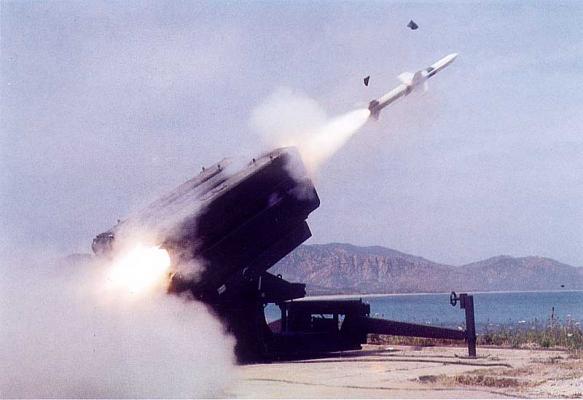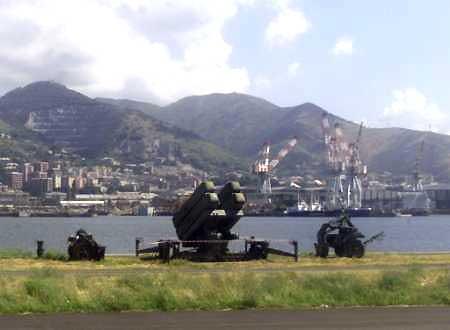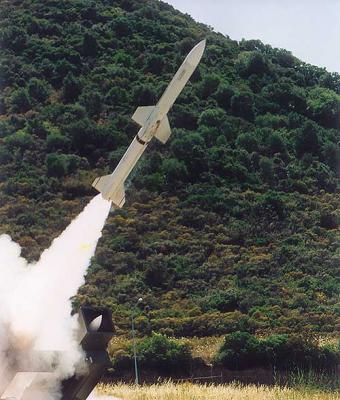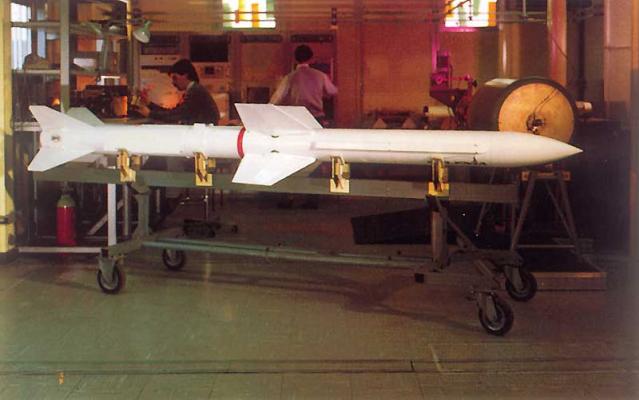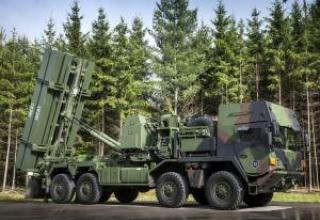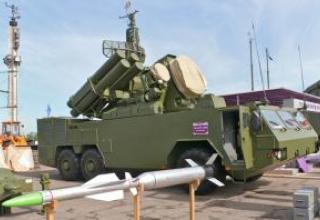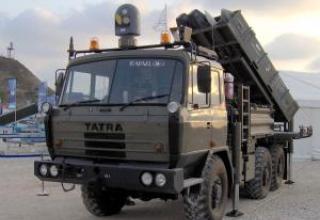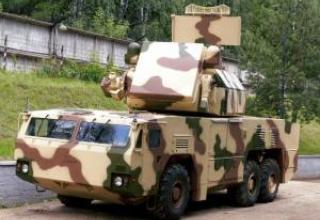All-weather medium-range anti-aircraft missile system "Spada" is designed for air defense of air bases, troop groups and other important military and administrative and political facilities. The system can be used against aircraft, helicopters and remotely piloted aircraft, including air-to-ground missiles. The system has a short reaction time, a high degree of automation, interference immunity and reliability.
Development of the complex was launched by the Italian company "Selenia" in the late 70's by order of the Italian Air Force. Tests of the system prototype were completed in 1977. The first battery went on duty in 1983, and by 1986 the Italian Air Force had already 12 systems in service. Four more systems were in service by 1991. In 1986, the Taiwan Air Force placed an order for one full battery "Spada", which was delivered in 1988.
The Spada" SAM system includes the "Aspide-1a" solid fuel missile (created on the basis of the American missile "Sparrow" AIM-7E), which is also used in the ship's SAM system "Albatros".
The Spada" complex has been repeatedly upgraded, the last version of the complex was designated "Spada-2000".
Composition:
The main elements of the complex are:
- Two-coordinate coherent-pulse radar detection and tracking station "Pluto",
- The radar escort and irradiation of the target,
- automatic data processing, display and transmission equipment,
- Aspide-1A anti-aircraft guided missiles,
- container-type six-charged launchers.
The complex is semi-stationary, the radar equipment of the operational control center and fire control center is placed in standard hardware containers, which are equipped with special jacks for installation on the ground. The jacks also contain launchers, platforms with detection radar antennas and illumination radar. Power supply generators of 75 kW each are placed on single-axle trailers.
The organizational structure of the SAM consists of a command and control station and firing sections.
The command post consists of "Pluto" radar and automatic data processing, display and transmission equipment. The electronic equipment of the radar is placed in the cabin, and its antenna is mounted side by side . The radar station, operating in the 10-cm wavelength range, can detect F-104 aircraft flying at low altitude, in conditions of interference from local objects at a range of at least 50 km. It uses advanced radar signal processing schemes and a moving target selection system. The transmitter has a radiating power of 135 kW and an antenna rotation speed of 15 rpm. Simultaneously with detection, the radar can accompany up to ten targets.
The radar for tracking and irradiation of targets operates in the frequency range of 4000-10 000 MHz. It has two transmitters: continuous and pulsed radiation, range - 30 km.
In the second cockpit of the command post, where the automatic data processing, display and transmission equipment is located, three workplaces for operators of combat calculation are equipped. The equipment is based on two NDS-1700 computers with 32,000-word memory devices and 18-bit capacity. On each operator's workstation there is an indicator (40 cm in diameter), on which by means of marks from the target and symbols the air situation is displayed, an indicator (18 cm) of alphanumeric information display, a keyboard for data input into the computer, as well as other control and monitoring units.
One of the operators controls the operation of the "Pluto" detection and tracking radar, i.e., depending on the combat situation, he chooses the method of interference control, determines the polarization of the emitted radar signal (horizontal or circular), enables the mode of selection of moving targets, etc.
The combat design commander is responsible for identifying air targets, assessing their threat level, making a decision on firing the most dangerous targets, distributing targets between firing sections, transmitting data about them to section control posts. The main processes of Spada SAMs control, from target detection to missile launch, are fully automated. The time from the moment of detection of an air target to its identification and from the beginning of data transfer to the control post of the firing section until the launch of the SAM is 10 s, so the total reaction time of the complex does not exceed 20 s.
The fire section includes one control station and three container-type launchers. The control station has a target tracking and irradiation radar with two transmitters. One (operating in the 5-cm wavelength range) is used to escort the target, and the second (in the 3-cm range) is used to irradiate the target, which is necessary to guide the SAM. The radar antenna is able to rotate through 360° azimuth and 0 to 70° angle.
There is one place for an operator in the control room of the firing section, who controls the operation of the radar and launchers, launches missiles, controls their flight and evaluates the results of firing. If necessary, the air target can be fired by two missiles. Despite the fully automated firing control, the SAM is constantly monitored by the operator, and he can stop pointing the missile by issuing a command to subvert it. To increase the interference immunity, the radar is coupled with a television escort system, which is used by the operator of the firing section control room under strong radio conditions.
The single-stage solid fuel missile "Aspide-1A" is equipped with a shrapnel-phase warhead, which is detonated when directly encountered with the purpose or when a non-contact radar fuse is triggered. Targeting is accomplished by means of a semi-active homing radar head operating in monopulse mode. Homing is carried out by the reflected energy of illumination or emitted energy of the interference driver. The missile is stored in an airtight transport and launch container. The full time required to fire the first target is 10-15 seconds and approximately 5 seconds for the next target.
The SAM is launched from a container-type four-charged PU (see layout diagram mounted on a single-axle trailer or a six-charged PU mounted on a two-axle trailer). The EE can be rotated through 360° azimuth at 50 degrees/s and has a fixed angle of 30° at the angle of space. In the combat position, the trailer is mounted on retractable telescopic supports. It shall be recharged by means of a crane mounted on the truck, which is simultaneously used to tow the launcher. The same vehicle is used to transport nine rocket launcher containers.
One command and control centre can operate four section control centres (the latter include up to three six-charges launchers). In this structure, the SAM system is capable of simultaneously firing four air targets, each with two missiles.
While the Spada SAM system is deployed in semi-stationary positions, all its elements are transportable. Their movement, including 48 rocket launcher containers, requires 14 vehicles, three of which must be equipped with truck cranes. The complex is also air transportable and can be transported by C-130 type military transport aircraft or CHinook CH-47 helicopters.
The maximum configuration of the battery can cover an area of up to 800 square kilometres and have 72 ready to launch missiles, which can be fired by one or a volley of two missiles.
Characteristics:
| Spada" SAM | |
| Maximum firing range, km | 15 |
| Minimal range of fire, km. | 1.7 |
| Maximum target altitude, m | 6000 |
| Minimum target acquisition altitude, m | 15 |
| Average intercept probability | 0,8. |
| Aspide-1A rocket. | |
| Length, mm | 3700 |
| Body diameter, mm | 203 |
| Wingspan, mm | 800 |
| Swing of stabilizers, mm | 640 |
| Start weight , kg | 220 |
| Weight RDTT, kg | 54 |
| RDTT operating time, s | 3,5 |
| Total pulse RDTT, kg/s | 120000 |
| Weight of shrapnel-flagged combat unit, kg | 33 |
| Maximum flight speed, M | 3.5 |
Testing:
On March 26, 1980, during the testing of a prototype projectile with a charge on high-energy ballistic solid fuel launched from the ML-20 base, there was a rupture of the missile part, which damaged the unit. See the electronic image of the photo (front and back) from the family archive of Vyacheslav Ivanovich Podchufarov (Russia, Tula) - participant of those works.
In 1980 Evgeny Alexandrovich Ganichev was awarded the S.I. Mosin Prize for his work on the theme "Development of RSZO "Smerch".
In 2002, the multiple launch rocket system "Smerch" "successfully passed tests in India, during which it confirmed its unique impact characteristics".
Sergei Sivtsov is a designer of control system elements. He made a significant contribution to the development of correcting switchgear for the angular stabilization systems of the Smerch and Hurricane Rocket Launchers. He took direct part in working out of the given elements, tests and their introduction in a batch production.
Sources:
- Викторов В. "Использование ЗРК "Спада" для обороны аэродромов ВВС Италии", Зарубежное военное обозрение,N5, 1984.
- Василин Н.Я., Гуринович А.Л. "Зенитные ракетные комплексы" .-Мн.: ООО "Попурри", 2002- 464с.
- Шунков В.Н. "Ракетное оружие" .-Мн.: ООО "Попурри", 2001- 528с.
